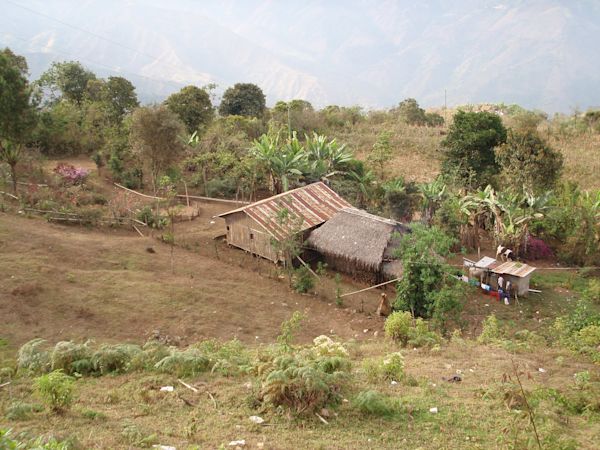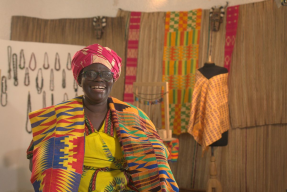All Loans Lead to Home; When an Agricultural Loan is also a Housing (or Student) Loan
December 15, 2011
By Marcus Berkowitz, KF16, Ecuador
“We built a little house” she replied happily, when I asked how she had used the loan. I looked down at my sheet. Oops. This loan, according to its Kiva description, was for corn seeds and fertilizers.

"A little house". Typical rural house made of wood, with a part-thatched, part-aluminum roof. Chillanes Canton.
Of course, we have no right to insist on any particular loan use. That’s not the point. But of the first three borrowers with whom I had spoken as part of Kiva’s Borrower Verification process, not a single one had used the loan for the purpose listed on Kiva. And two of three had built houses with their loans. What gives?
As I continued with other projects such as redesigning the way that the Cooperativa San Jose in Ecuador gathers information for Kiva profiles and follow-up journals, I found a clear common thread. Often (though not always) families’ ultimate goal is to build or upgrade their house, whether directly by putting some of the loan money into home improvement, or indirectly by using the loan to grow their business, and then funneling the increased profits into their housing plans. Their other most common long-term goal is the education of their children, to which a similar dynamic of direct and indirect funding applies.
Upon discovering this, my first thought was a critique; well, obviously CSJ isn’t adequately meeting all of its borrowers’ needs. They should offer housing and student loans, I concluded, and we should fund them through Kiva. I was going to find out why they didn’t.
The truth, as always, turned out to be much more complicated. For poor folks in Ecuador, building or adding to a house usually means upgrading from a somewhat rickety wooden structure (see image above) to a stronger cement-walled building (see images below), as well as purchasing furniture and the interior decorations that make it nice to live in. It is expensive, so people tend to do it in stages instead of all at once. (For an excellent discussion of an innovative solution to the same problem in Mexico, check out Part II, Section I, starting on pg. 147 of this book)
And CSJ does offer housing loans for this purpose, but the law requires that the potential house be posted as collateral. Easy, right? Anything but.
In order to post the house as collateral, one needs an architect’s official evaluation of the property that the borrower owns. Aside from the absurdity of expecting low-income borrowers to hire an architect, the concept of property value presents tricky challenges of its own.
Many of Kiva’s borrowers here belong to Ecuador’s large indigenous community, composed primarily of the Quechua (and Spanish) speaking modern day descendents of the Incas. By Ecuadorian law, they are allowed to own land collectively rather than individually, and most do. This means that they are unable to get the individual property deeds that underpin the official evaluations of land needed to get housing loans.
Those who are not indigenous are often living on land that is either rented or to which they have no specific deed or claim. This too makes evaluation impossible.
Student loans have curveballs of their own. They are exclusively for higher education, but most of Ecuador’s low-income borrowers’ kids could use the financial help just to get through high school.
So it makes sense that micro-loans end up in practice being used for both of these purposes because, though small, they conveniently skirt these obstacles. But what should our reaction be as lenders?
The answer is; a big thumbs up (Or perhaps one that inverts itself for just a second to hit Kiva’s “Lend” button, before returning to its upright and locked position).
Housing upgrades can make life a lot less precarious for borrowers. Cement is of course a lot less likely to burn, flood, or rot than wood. This can be an enormous benefit in the face of unpredictable events that seem to happen much more frequently in the precarious environments to which poorer members of Ecuadorian society are often relegated.

A cement house under construction in Ventanas Canton. A Kiva borrower with a contracting and soldering business works on this site.
And spending on schooling can have obvious benefits on the earning power of the children on which it is spent. But in a society where children are often expected to take much closer care of their parents in old age, the benefits of an educated daughter or son can often accrue directly (although, of course, with a lag) to the patient parent and borrower who funded the education in the first place. If the goal is give borrowers the tools to improve their quality of life, in addition to expanding their businesses, these expenditures have the potential to be overwhelmingly successful.
There are many roads that lead to the improved welfare of borrowers. So take the loan labels with a grain of salt, but trust borrowers to use your loaned funds to improve their lives in whatever way they choose.
Marcus Berkowitz is a first-time fellow with Cooperativa San José (CSJ) in the western Andes of Ecuador’s Bolívar province. Show support for CSJ´s hardworking rural borrowers by making a loan. Or get even more involved by joining CSJ’s lending team!















